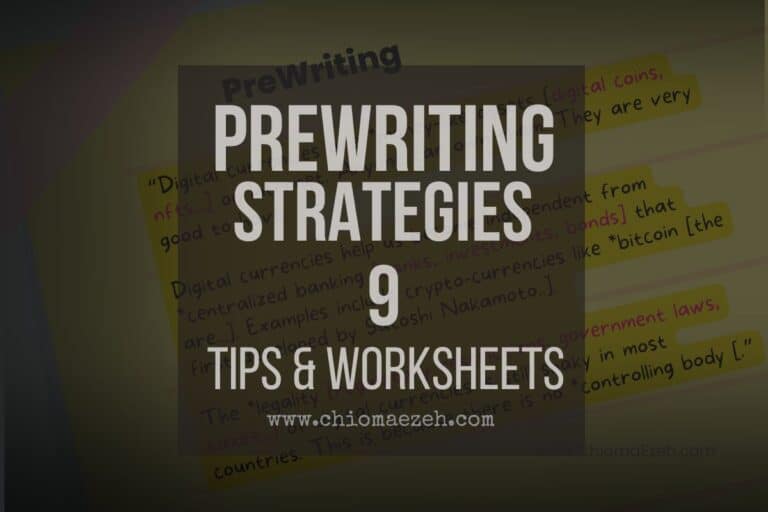How to Write for a Lay Audience: 11 Steps To Craft An Engaging Piece
The language you use in writing can determine how well received it is. While niche professionals can get away with certain language and jargon that their audience can relate to and understand, the same cannot be said for a lay audience.
So, how can you write for a lay audience? What makes the lay audience so special? In this post, we’ll discuss how to write for a lay audience. We will also understand why it’s important to learn to do so and why they matter.
Read till the end, because we’re going to provide examples of content written for a lay audience versus an expert/professional one.
👉 See our comprehensive guide: Audience In Writing: A Simple Guide for Writers & Authors
Let’s Talk
Are you a writer aspiring to pen a masterpiece that never fails to captivate? Look no further. Reach out to us and uncover how we can help you to take your writing to unprecedented heights!

What is A Lay Audience?

A lay audience is people with little to no knowledge or background in a particular topic or field. They need information to be written in a way that is easy to understand, using language and terminology they are familiar with.
Writing for such an audience requires the person writing the content to simplify complex concepts and provide clear explanations. They often need the writer to use lots of examples and analogies to explain difficult points.
So, writing for a lay audience means that you must avoid technical jargon and instead use simple language that can be understood by anyone, regardless of their background.
Use Our Readability Calculator
Readability Score:
Interpretation:
How to Write for a Lay Audience:
Below are steps to take to create content that appeals to and resonates with people not in your industry.
1. Determine your writing purpose

First, know your writing’s main goal. Are you trying to inform, entertain, or persuade your audience? If you’re trying to inform, you’ll need to focus on providing accurate and unbiased information. If your goal is to entertain, make sure your writing shows a creative flair that captivates your reader. Persuasive writing requires an effective argument to be made, so think carefully about what you want to convince the reader of.
For example, if you write about recycling, you want to teach readers the benefits and give practical tips for recycling in daily life.
2. Know your lay audience.
You can’t write great content if you d not know and understand your audiences. Learn who they are and what they like. Know their needs, and their challenges. Research, talk to them, or use surveys to gain insight into their needs.

If you write about recycling, consider who your readers are and what kind of information they need. Are they motivated by cost savings or environmental concerns? Do they know how to recycle items in their area?
Likewise, if your audience is young adults interested in sustainable living, you might write about eco-friendly products or reducing their carbon footprint.
3. Explain key terms
Explain technical terms or jargon your lay audience might not know. Clear definitions help readers understand your content without getting lost. And this will also show that you respect them.
For example, instead of using the term “photovoltaic cells,” rather, say, “solar panels that change sunlight into electricity.” This makes the term easier to understand.
4. Make difficult ideas simple
Lay readers often have a limited understanding of complex topics. So, make sure to simplify difficult ideas and processes as much as possible. Break down complex concepts into simple steps. Use analogies, examples, or step-by-step explanations to explain them.
For example, you can explain the greenhouse effect like this:
“The Earth is like a car parked in the sun with closed windows. The sun’s rays go through the car windows, making the inside hot. Greenhouse gases, like carbon dioxide, trap heat in the Earth’s atmosphere, making global temperatures rise.”
5. Use simple Language
Use simple words instead of technical terms when possible. Watch out for your tone and voice. Avoid using overly formal language, big words, and long sentences. Try to make your writing easier to read and understand. Use everyday language that will help your readers understand your points more quickly.

To write in simple language, follow these tips:
- Pick short, simple words over long, complicated ones. For example, use “use” instead of “utilize.”
- Don’t use jargon or technical terms unless you’ve defined them.
- Write short sentences and paragraphs to make your text easier to read.
- Use active voice to make your sentences engaging and easy to understand. Instead of writing, “The ball was kicked by the player,” say, “The player kicked the ball.”
- Give examples and stories to show your points. This helps readers relate to the content and understand the concepts.
- Keep a friendly tone in your writing. This makes it easier for your readers to connect with your content.
6. Use short, direct sentences
Write short sentences to make them easy to read and understand. Focus on one main idea per sentence. Even if you have more to say about the topic, divide it into several sentences. Also, use direct language without any filler words or phrases.
For example, instead of saying “it is possible in order to,” just say “to.” This makes your content easier to read and understand.
I like to keep sentences no longer than 20 words per sentence (except where its absolutely necessary) and three sentences per paragraph.
7. Be direct
Be direct and share the most important information in a clear way. Avoid too many details. Oftentimes, I see authors writing long paragraphs to explain a single idea. This makes it hard for the readers to stay focused or find what they want. Not that you should keep things overly simple, but it makes more sense to be concise for your lay reader.
Imagine you have an article about organic farming. You can write on its benefits and challenges instead of going into lengthy details about some background history or theory. Because you’ll probably need to focus on one or two aspects rather than trying to cover everything.
See this example:
“Regular exercise helps improve heart health, increase energy levels, and reduce stress.” This statement is clear, direct and states the main benefits of exercise.
Now compare it to “Regular physical activity can lead to an enhanced quality of life due to improved cardiovascular health, increased energy levels, and decreased stress levels.”
This statement is much longer. Both statements convey the same message, but the first is simpler and easier to grasp.
8. Use examples and analogies
Use examples and analogies to make complex ideas easy to understand. I cannot emphasize this enough. It’s one magic bullet that can turn a technical, and hard subject into a simple and relatable one.

For example, let’s say you want to explain the concept of artificial intelligence (AI). You can start by saying: “AI is like a super-smart computer that can learn from its environment to improve its performance.” This is an analogy that most people will understand easily.
You could also provide an example of AI in action:
“Google’s self-driving car is powered by AI that can detect obstacles on the road and react accordingly.” This real-life example helps readers understand what AI is and how it works.
Compare with:
“AI is a computer system that uses algorithms and Machine Learning techniques to independently acquire knowledge and skills.”
This second statement is more technical and doesn’t explain the concept in an easy-to-understand way.
9. Add visuals and other media.
Audiences today respond well to visual content. Use images, diagrams, videos, or charts to explain concepts wherever possible. A report stated more people are moved by what they see than what they read. And lay people are more likely to remember a visual than words.

Visuals also help break up long pieces of text and keep things interesting. However, the visual you use should be relevant to the content.
Let’s say you have an article about 3D printing technology; include some pictures of 3D-printed objects, the printer, or even the process itself. You can also use an infographic to show the different stages of the process instead of writing about it. You can also add screenshots for tutorials or examples that involve images or text.
For abstract topics like leadership or communication, use diagrams or videos to help explain the concept. Most times, visuals are more efficient than words because they make it easier to understand a concept.
10. Use the active voice
Use active voice to make your writing engaging and clear. This means avoiding passive voice as much as you can. Generally, active voice sentences are the go to for relatable writing – writing that engages and compels one to take action.
In active voice, the subject of the sentence is performing the action. For example: “Our team developed a new software.” In passive voice, the subject of the sentence is receiving an action. For example: “A new software was developed by our team.”
Unlike active voice, passive voice sentences are often formal, boring, convoluted, and hard to follow. This does not make for good reader engagement. But active voice makes your written work easier to engage with. As such, it’s best to avoid using passive voice when writing for lay people.
👉See our guide to active and passive voice for authors
11. Use the second person POV
Use the second-person POV to make your writing more relatable. If you notice, I have written this post in the second person point of view. This pov means that you are addressing your readers directly using words like “you” and “your.”

The second person POV helps you create content that is more personal and engaging. It can make your reader to easily relate to your content as if it was written specifically for them.
For example, instead of saying, “Everyone should read this article,” say, “You should read this article.”
This latter is more direct and personal. Not only does this work to make the content more personal, it leads to better engagement, which can make your reader to take action. This would make much sense if your writing purpose is to persuade them to take a specific action.
Writing For Lay Vs Expert Audience
See our table below for differences between writing for a lay audience and an expert one.
| Aspect | Lay Audience | Expert Audience |
|---|---|---|
| Purpose | Inform, entertain, or persuade | Share specialized knowledge or discuss a niche topic |
| Language | Simple, everyday language | Technical jargon and industry-specific terms |
| Sentence Length | Short, direct sentences | Longer, more complex sentences |
| Tone | Friendly, conversational | Formal, academic |
| Use of Examples | Frequent use of examples and analogies | Limited use of examples, focus on facts and data |
| Visual Aids | Images, diagrams, videos, or charts to explain concepts | Graphs, charts, or technical diagrams |
| Voice | Active voice | Active or passive voice, depending on context |
| Point of View | Second-person POV | Third-person POV |
Example Content For A Lay Audience (Vs Expert)
Let’s compare an example of a piece written for a lay audience. Then, we will compare it with content written for a professional or expert audience. Try not to miss the distinctions as you go through them.
Let’s assume we want to write a blog post on “Investing in The Stock Market.”
For a lay audience, this is how close it should come:
Investing In The Stock Market: Written For A “LAY” Audience
It can be hard to understand the stock market if you don’t know much about it. But it is important to learn the basics of the stock market so you can make good decisions with your money. This article will explain how the stock market works so you can understand it better.
When you buy stocks, it means that you are buying a part of a company. It is like buying a piece of the business and having a say in how it’s run. Buying stocks means that you are joining the stock market and can take part in trading – buying or selling shares as the price of the stock changes. When the stock market goes up, it means that people are buying more shares and paying more for them. When the stock market goes down, it means that people are selling off their shares and not getting as much money for them…
As you can see, the simple language employed subtly explains concepts as you read along. Notice the breakdown of points and concepts to a minimal level of knowledge.
Let’s compare that with the one below written for a professional/expert audience.
Investing In The Stock Market: Written For An EXPERT Audience
The stock market is a complex and ever-changing landscape, making it one of the most difficult and unpredictable financial markets to navigate. It can be difficult for both novice and experienced investors to keep up with the fast-paced market conditions, as they must stay informed on numerous factors that can influence stock prices. For those looking to build their wealth by investing in stocks, it is important to keep up with the latest market trends and developments to ensure that they are making informed decisions.
In this article, we will provide some tips for becoming a successful stock investor. First, it is important to do your research before investing. Make sure you understand how different stocks and sectors are performing, what the current market trends are, and what the risks of investing in each sector may be. You may need diversify your portfolio by investing in a variety of stocks and sectors. This will help manage risk so that if one stock or sector performs poorly, it won’t have a significant impact on your overall investments…
This aptly captures what a pro audience will relate to.
Free Lay Writing Template for Writers
Here’s a free template to help you create content that is accessible and engaging for non-experts.
Lay Audience Writing Template:
- I. Introduction
- A. Hook: Engage the reader with an interesting statement, question, or anecdote.
- B. Context: Provide a brief overview of the topic and why it’s important.
- C. Thesis: State the main point or argument of your content.
- II. Body
- A. Main Point 1: Clearly state the first main point.
- 1. Explanation: Break down complex concepts, use examples or analogies.
- 2. Evidence: Provide relevant facts, data, or anecdotes to support the point.
- B. Main Point 2: Clearly state the second main point.
- 1. Explanation: Break down complex concepts, use examples or analogies.
- 2. Evidence: Provide relevant facts, data, or anecdotes to support the point.
- C. Additional main points: Repeat the pattern for each additional main point.
- A. Main Point 1: Clearly state the first main point.
- III. Conclusion
- A. Restate the thesis: Briefly restate the main point or argument.
- B. Recap the main points: Summarize the main points discussed in the body.
- C. Call to action: Encourage the reader to take further action or learn more about the topic.
Why Do Lay Audience Matter?
Writing for people who aren’t experts is important for many reasons:
- Reach more people: When you write for a lay audience, more people can understand and care about your work.
- Better communication: Writing in a simple way helps you learn how to explain things clearly, which is useful in all parts of life.
- Help people make choices: When you make your work easy to understand, you help people make better decisions.
- Build trust and support: Writing clearly can help people trust and support your work, which may lead to more sales or funding for your projects.
- Teach others about complex topics: Writing for lay people helps teach them about complex ideas. This can make them more interested in science and other technical subjects.
- Include different viewpoints: Writing for everyone helps you include different opinions and backgrounds, which will make your work more relevant to all kinds of people.
- Think about ethics: Writing for non-experts makes you think about how your work affects people and society. It can make you more empathetic, reasonable, and responsible.
In short, if there’s one sentence I’ll have to use that best summarizes this, I’ll say, “Writing for a lay audience simply makes you a better writer”. If you can explain concepts in simpler ways, then it makes you an even better teacher.
Plus, writing for non-experts helps make your work useful for more people. It helps teach others, builds trust, and makes people make good decisions.
As a matter of fact, most people who will probably come across your work will be lay readers. So that should count for more reach.
FAQs On How To Write For A Lay Audience
How Can You Identify A Lay Audience?
You can determine a lay audience by looking at several of the following qualities:
- No specific expertise in the field
- Have a limited understanding of complicated concepts
- Need to be briefed on technical terms and jargon
- Prefer straightforward language that is easy to understand
- Benefit from examples, analogies, and other visuals to aid their understanding
- Appreciate clear, concise writing
- Will benefit from a well-structured piece of writing that is easy to follow.
What Are The Benefits Of Writing For A Lay Audience?
Writing for a lay audience offers many benefits.
First, it allows you to reach a wider audience and spread your message to those who may not have extensive knowledge in the given field. Writing for a general readership can also help build trust between yourself and your readers.
By explaining complex topics in language that anyone can understand, you demonstrate that you are knowledgeable and respectful of their background. Lastly, writing for a lay audience can help increase engagement and understanding of topics previously considered too difficult or technical.
Video Recommendation: Writing With Your Audience In Mind
Final Notes on How To Write For A Lay Audience
Writing for lay people doesn’t have to be difficult. Use these tips and techniques to make complex topics easy to understand. Keep sentences and paragraphs short, be direct, use examples, analogies, visuals, and other media to better understand the topic, and write in a language they can easily understand. Doing this will make your writing more effective.
We hope this guide has given you a better understanding of how to write for a lay audience. With these tips, you can begin to tailor your book and articles to your audience, especially if they are the general public or lay audience.
Recommended Reading:



![How To Write Dialogue Between Doctor And Patient [13 Templates]](https://chiomaezeh.com/wp-content/uploads/2023/04/how-to-write-dialogue-between-doctor-and-patient-768x512.jpg)

![Outlining In Writing: 6 Easy Steps For Success [With Formats]](https://chiomaezeh.com/wp-content/uploads/2023/01/What-is-outlining-in-writing-process-768x512.jpg)
